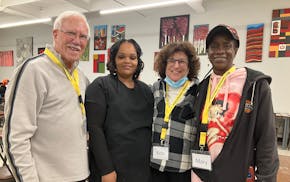If you have a soft spot for retro holiday decor, a new book will inspire nostalgia. Sarah Archer's "Midcentury Christmas" (Countryman Press, $24.95) spotlights the "Holiday Fads, Fancies and Fun From 1945 to 1970." That's when traditions moved from Victorian charm to the post-World War II era of widespread prosperity — and the modern Atomic Age.
Imagery evoked speed, movement and light — but was also inherently festive. So it was quickly adopted by designers of Christmas cards, wrapping paper and toys, Archer said. As a result, many midcentury decorations, such as the shiny metallic tree, were modern and cutting-edge.
One of Archer's favorite kitschy traditions from this period is the televised yule log, which originated in 1966.
"Visually, there's no better metaphor for the midcentury holiday symbol of the ancient hearth and fireplace encased inside a gadget — a TV," she said.
Archer's insightful book also explores gifts, greeting cards, shopping and toys, and incorporates scores of ads, illustrations and magazine spreads that evoke the style and aesthetic of the midcentury period. We chatted with Archer about Charlie Brown, metallic trees and other retro collectibles:
Q: Why did a high-tech version of Christmas enter American homes after World War II?
A: People were fascinated with the novelty of all the new products and gadgets with bright colors, atomic shapes and abstract patterns. Designers were trying to make the idea of atomic energy more exciting and accessible — not scary. Plus there was this new optimism, and people could kick up their heels and shop.
Q: What are some iconic decorations from the 1950s and '60s that have a distinctive look and style?
A: Strings of colorful lights with big bulbs — the packaging always stressed safety — and water bubble lights. Shiny Brite was the first American-made glass ornaments by Corning Glass Works. Before that, ornaments were imported from Germany.
The aluminum tree was a very popular but short-lived fad. You couldn't use electric lights so they came up with rotating color wheels. My guess is that the late 1960s hippie movement made them uncool.
Q: How does the 1965 TV special "A Charlie Brown Christmas" represent the commercialization of the holiday?
A: The story so well addresses the aluminum Christmas tree vs. the sad "Charlie Brown tree." It's about coming to grips with the new consumer landscape and the availability of things that are high-tech and cool — but feel artificial.
Q: How were the contradictory handmade Christmas crafts and sleek modernist design elements both popular during the 1950s and '60s?
A: You'd see an aluminum tree side by side with a woven wall hanging. Lots of magazines and marketing promoted the fun idea of DIY crafts using shiny glittery materials. There were two different styles — but one inspired the other.
Q: Why are retro decorations such hot collectibles today?
A: They're so over-the-top festive, fun and kitschy. Find a Sputnik tree topper or mini-aluminum tree your parents or grandparents had. It's also an affordable way to collect modern design.

Minnesota veteran makes 1,000-mile 'gratitude walk' for program that helps vets

At 90, Minneapolis volunteer has lifetime of service

Betting on Uptown

